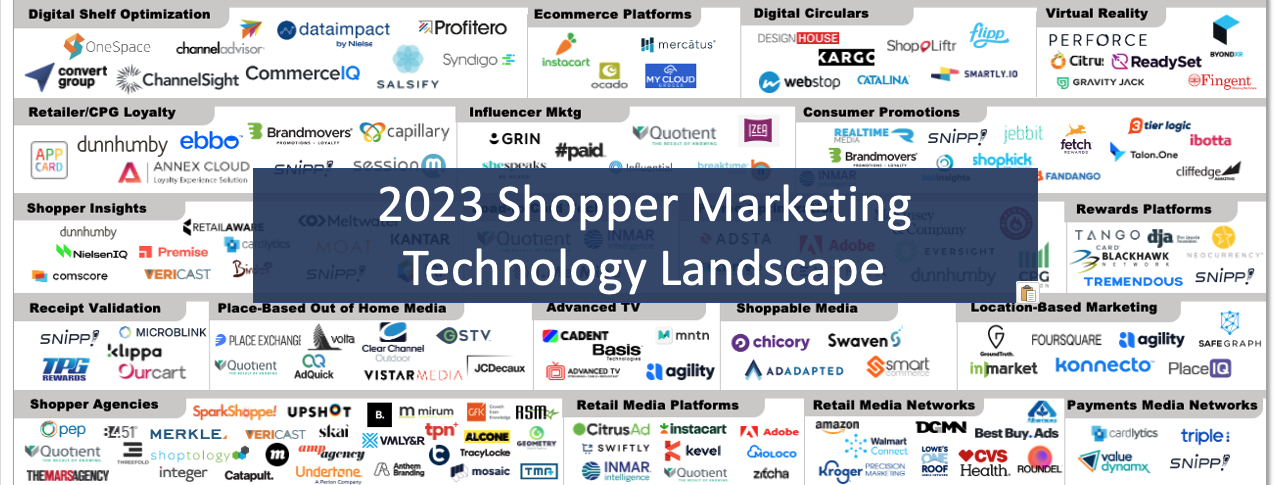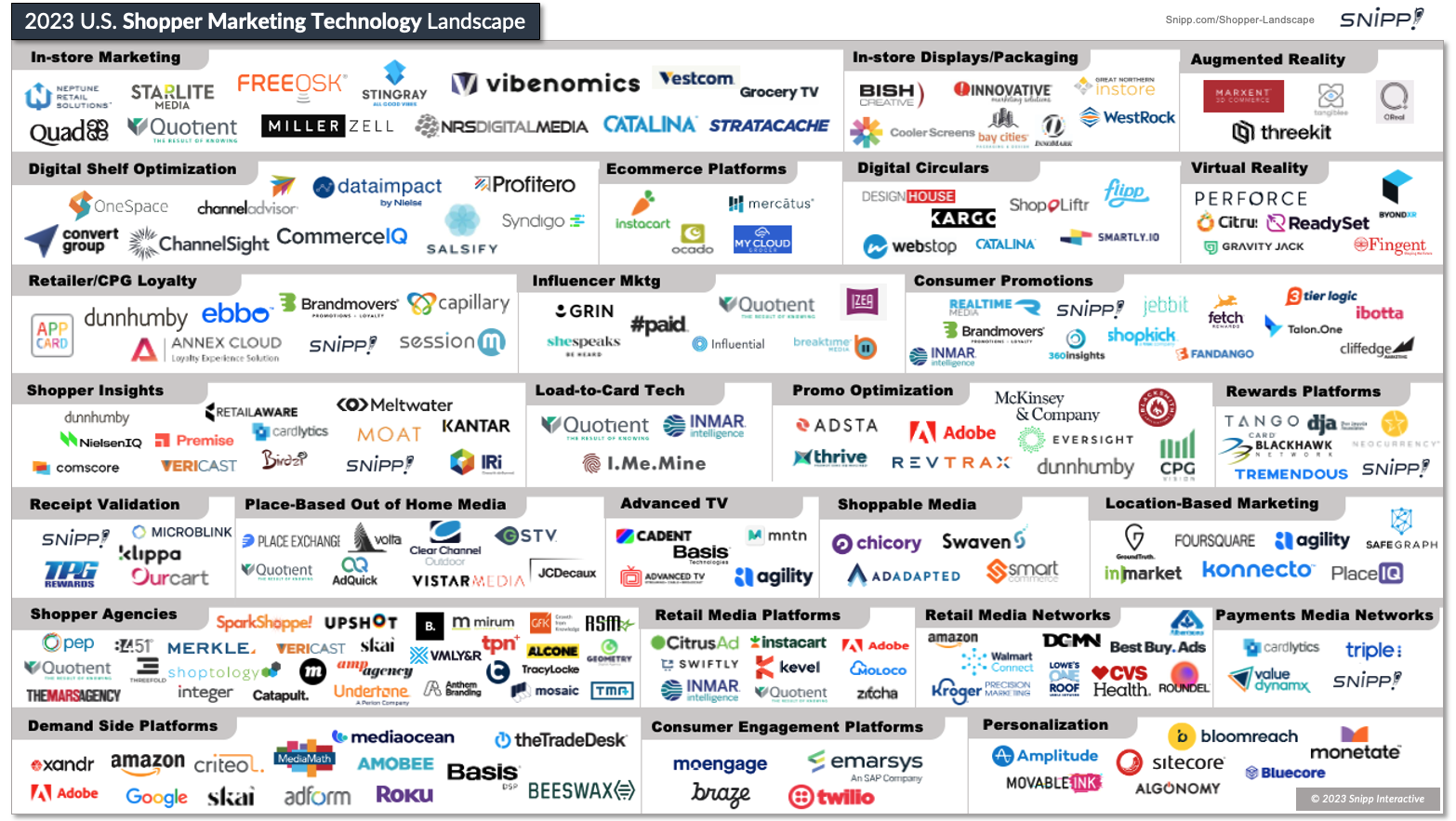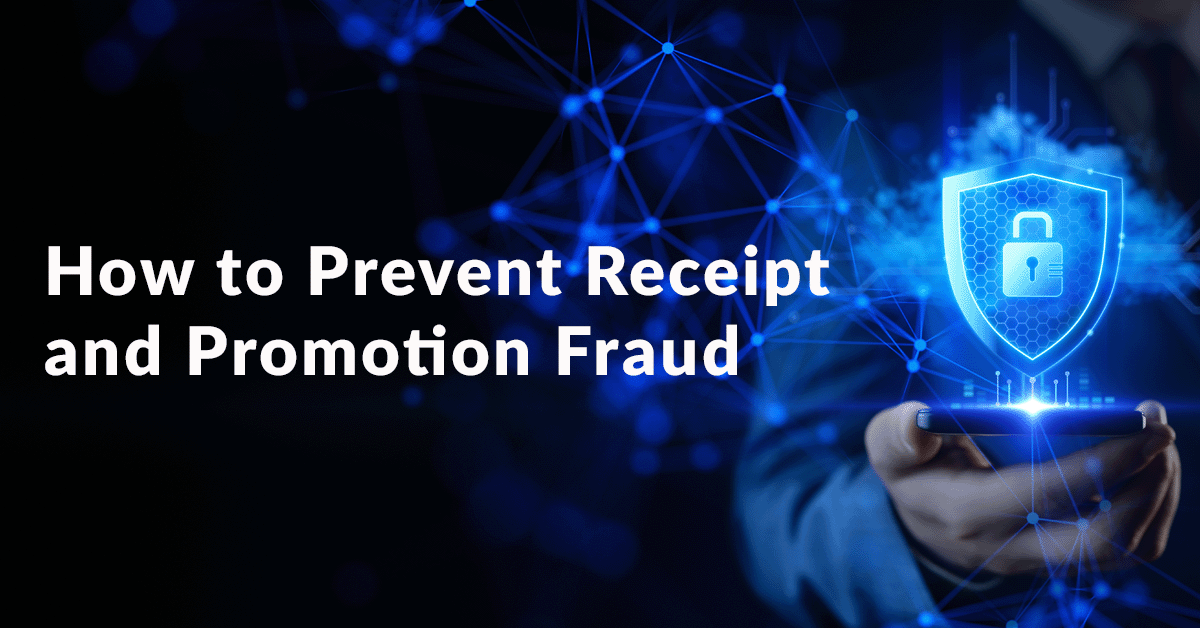If shopper marketing is the engine of commerce that connects consumers, brands and retailers, shopper marketing technology is the spark that ignites an array of new innovation and solutions - all the way from in-store signage to the expansion of e-commerce and shoppable media to immersive experiences in the Metaverse, the industry is blazing with change.
Shopper marketing’s main objectives remain the same, but with an array of new entrants, the playing field can change quickly. Keeping pace can be difficult, so we’ve created this 2023 Shopper Marketing Technology Landscape to help contextualize the ecosystem and to serve as a jumping off point for exploring and making strategic discussions on how your brand, agency or retail establishment embraces Shopper Marketing and some of the new technologies and tools.
Feel free to drop us a line with any feedback, additions or changes for us to consider in upcoming versions of the landscape. We’d love to hear from you!
Shopper Marketing Technology Landscape 2023
Without further ado, here is the 2023 Shopper Marketing Technology Landscape. Click on the image for a larger version (or here for a PDF Version). See below the graphic for details about each category included in the landscape.
Resources:
- Click for a larger version of the Tech Landscape
- Click to get the full PDF Version of the Shopper Tech Landscape Report to share
- Click to provide feedback or suggestions
Related Content (see drill-downs in particular areas or topics):
- 7 Trends Changing the Future of Shopper Marketing
- Retail Media for Main Street - The $100 Billion Dollar Opportunity
- I want my CTV! Why Advertisers Are Tuning Into Advanced TV Media
- Retail Media Networks for Banks? The definition of a Payments Media Network
- What is a Shopper Marketing Agency (and clickable list of agencies)
- Augmented Reality Shopping - How Brands & Retailers Drive Differentiated Experiences
Shopper Marketing Technology Definitions
In-store Marketing
In-store marketing refers to the marketing tactics and strategies used by companies to promote their products and services in the physical retail store setting. This can include point-of-sale displays, product demonstrations, signage, promotional materials, product packaging, and in-store events. The goal of in-store marketing is to drive sales and increase brand awareness by engaging customers directly at the point of purchase. While most of these tactics have not significantly changed in decades, networked in-store digital screens have enabled marketers to be more nimble with pricing and responsive with media to optimize their investment in brick-and-mortar retail.
In-store Displays/Packaging
These companies provide a variety of in-store displays and packaging, including on the shelf, end-caps and cooler doors, located throughout retail environments. Solutions can include custom displays or signage, packaging design, and product demonstration set-ups. While many approaches to displays and packaging have remained mostly unchanged, new display technologies on shelves and freezer doors are allowing for innovation in this area.
Augmented Reality
Augmented Reality (AR) for shopping refers to the use of AR technology in the retail environment to enhance the shopping experience for customers. AR allows brands or retailers to display virtual product information, images or video content overlaid on real-world objects, creating an immersive, interactive and personalized shopping experience. Some common applications of AR for shopping include virtual product fittings, product information overlays, in-store navigation or visualization of products (e.g. on a person or in a home).
Digital Shelf Optimization
Digital shelf optimization refers to the process of optimizing a company's digital presence on online retail platforms to improve the visibility, relevance, and appeal of their products to customers. This involves using a variety of digital marketing strategies, such as search engine optimization (SEO), paid search advertising, product data management, and content creation, to make sure that a company's products are easy to find, including compelling product descriptions and images, and are competitively priced on online retail platforms. DSO can help increase brand awareness, drive sales, and improve customer engagement.
E-Commerce Platforms
An e-commerce platform provides businesses with the tools and infrastructure needed to sell products and services online. It can include website building tools, shopping cart functionality, payment processing, order management, shipping and tax calculation, customer management, and marketing and analytics tools. For retailers, these platforms allow them to operate the e-commerce portion of their business.
Virtual Realty
Immersive and interactive experiences delivered by brands or retailers. The experience can include a virtual showroom, virtual events, experiences (e.g. test driving a virtual car), events (virtual concert) or virtual product demonstrations/training. They can be delivered in a custom environment or in an existing virtual environment like Roblox, Decentraland or Fortnite.
Retailer/CPG Loyalty Solutions
Providers of software for retailers or brands designed to increase customer loyalty, drive repeat purchases, and encourage greater spend.. These programs typically offer rewards and benefits for customers who make purchases, such as discounts, free products, exclusive promotions, and special events. Loyalty programs are often structured around a points system, where customers earn points for every purchase they make, which can then be redeemed for rewards. Some programs may also offer tiered benefits, where customers receive greater rewards as they reach higher levels of points or purchases.
Load-to-Card Technology
Load-to-card technology companies integrate with retailer’s point-of-sale systems to provide loyalty rewards solutions including “clip-to-card” digital coupons published on retailers digital properties and mobile apps. To redeem, shoppers simply select or “clip” offers from a gallery of coupons and present their frequent shopper card at checkout. The savings are automatically taken at the register.
Digital Circulars
Solution providers that digitize retailers’ weekly circular offers. As more shoppers are engaging with retailers online these solution providers are stepping in to deliver more personalized versions of retailer’s TPR’s (temporary price reductions), discounts and sale items. They can be delivered to customers through email, mobile apps, or online platforms, and provide a convenient and accessible way to view the latest deals and promotions from their favorite retailers. They can also include interactive features, such as links to product pages, the ability to add items to a shopping list, or the ability to make a purchase directly from the circular.
Consumer Promotions
Consumer promotions are marketing activities aimed at encouraging consumers to make a purchase. These promotions can take the form of discounts, buy one get one free (BOGO) offers, rebates, free samples, contests and sweepstakes. There are technology components supporting the promotions such as QR codes, mobile apps, website landing pages, receipt (or non-receipt) validation and reward fulfillment. Consumer promotions are often used by brands and retailers to increase sales, clear out inventory, drive traffic to stores, or to introduce new products.
Shopper Insights
Shopper insights provide deeper understanding of the motivations, behaviors, and preferences of consumers when they are shopping. These insights help brands and retailers better understand the needs and wants of their target audience and inform their decision-making about product offerings, marketing, and the overall shopping experience. Helping brands and retailers understand shoppers by centralizing disparate data points to create a more unified view of their behaviors.
Influencer Marketing
Agencies and technology platforms that offer access to social media influencers and content creators, often those with a large following on Instagram, YouTube, or TikTok. The goal is to reach and engage with a brand’s target audience. Influencer engagement can include sponsored posts, product reviews, advertising or brand takeovers. Influencer marketing is nothing new, however more brands are seeing it as a viable alternative to traditional media.
Promo Optimization
Solutions to help brands optimize their trade spending, promotions and offers at retail accounts to increase effectiveness, maximize profitability and gain market share. This may involve analyzing data on customer behavior, sales, and other factors to determine which promotions are likely to drive the most revenue or customer engagement and then adjusting the promotions accordingly. The goal of promo optimization is to achieve the best possible results from promotional campaigns while minimizing costs and maximizing customer satisfaction. Closing the loop between trade promotion and retail sales has been a perennial challenge for brands in sales channels they don’t control.
Rewards Platforms
Rewards Platforms connect to loyalty programs or shopper promotions and allow for delivery of rewards such as gift cards, rebates, physical items, experiences, trips and many more. The platforms typically include a large catalog or rewards options and handle fulfillment.
Receipt Validation
Receipt Validation solutions for brands to track and measure purchases across various outlets. Brands are often locked out of receiving rich consumer data that retailers receive at point of purchase. Because receipts (physical and digital) contain a wealth of data on shopping habits, product and retailer information, and they are one of the best proof-of-purchase mechanisms for consumer promotions and loyalty programs. Brands rely on Receipt Validation to understand which retailers are driving the most brand engagement, to perform basket analysis, and to understand buyer repeat purchase behaviors.
Place-Based Out of Home Media
Outdoor static and digital signage advertising and media networks displayed in places such as shopping malls, airports and public transportation. Similar to the path digital media took over a decade ago, Out of Home Media has now gone programmatic. This provides advertisers the ability to purchase media on self-serve ad networks, delivering them the flexibility to launch campaigns in real-time, scale up or down and in some cases measure their media based on actual retail sales.
Advanced TV
Addressable TV, Convergent TV, Linear and Over The Top (OTT) are all terms that fall under the Advanced TV umbrella. They all involve a higher level of targeting when compared to traditional broadcast media. Advanced TV gives advertisers the ability to reach specific households on a one-to-one basis as opposed to traditional one-to-many TV media.
Shoppable Media
Shoppable media is the integration of e-commerce features into traditional media content, such as articles/blog content, recipes, video, television shows, advertisements, print (e.g. with a QR code) and social media posts. By allowing consumers to purchase products directly from the content they are viewing, shoppable media can help bridge the gap between traditional advertising and e-commerce, creating a more seamless shopping experience for consumers.
Location-Based Marketing
Location-based marketing applications use location data to deliver targeted and personalized marketing messages to consumers. This is typically done through mobile devices and involves the use of technologies such as GPS, Wi-Fi, and Bluetooth to determine a consumer's location. Geofenced advertising and audience measurement solutions help brands efficiently deliver ads and measure the impact at specific retailers and physical locations.
Shopper Marketing Agencies
Agencies dedicated specifically to shopper marketing initiatives, often supported by many of the technologies on this landscape. Shopper marketing agencies have always stood at the nexus between branding and selling. This balancing act, understanding of brand and retailer business objectives and focus on accountability is what sets them apart from traditional ad agencies. As shoppers move effortlessly between in-store and online channels, shopper agencies have become more adept at delivering new marketing opportunities to their clients especially in the areas of digital, retail media and emerging technology.
Retail Media Platforms
Third party technology solutions for retailers to enable brand advertising and promotions on their owned digital media assets. Retail media was once reserved for brick-and-mortar titans like Walmart and Kroger but is now a growing opportunity for regional grocery and drug retailers. Tech providers like Kevel, and CitrusAd have made it easier for these smaller players to monetize their digital assets, allowing their brand partners to market directly to their digitally engaged shoppers.
Retail Media Networks
Retailer-owned media networks that enable brand advertising and promotions on their owned digital media assets. Many larger retailers continue to embrace digital and are acquiring the internal resources to create and manage their own Retail Media technology. In other cases, they work with the Retail Media Platforms to manage their Retail Media Network.
Payments Media Networks
A Payments Media Network (PMN) is a newer category of technology that allows brands and retailers to reach a bank’s audience with SKU-level offers and promotions. It manages SKU-level advertising campaigns, displays offers to consumers, matches purchases against promotions and provides reporting and insights to allow for better personalization and targeting.
Demand Side Platforms
Demand-side platforms are programmatic ad platforms that allow advertisers and media agencies to bid automatically on desktop, mobile and search ad inventory from a network of publishers. They provide a centralized interface for advertisers to access and bid on digital ad inventory from multiple ad exchanges and supply-side platforms (SSPs) in real-time.
Consumer Engagement Platforms
A consumer engagement platform helps brands and retailers to connect with consumers and build relationships through personalized experiences and interactions. CEPs help marketers deliver more personalized and one-to-one experiences across disparate communication channels including SMS, Email, and Digital Ads.
Personalization Solutions
Personalization solutions are technologies that enable businesses to deliver customized experiences to their customers based on their individual preferences, behaviors, and history. This includes personalization engines, Customer Data Platforms, Content Hubs and AI platforms designed to create more personalized engagements that drive better outcomes for clients.






